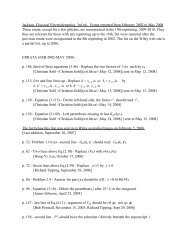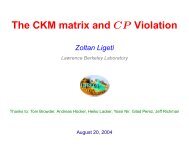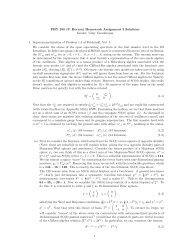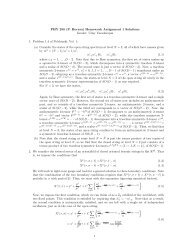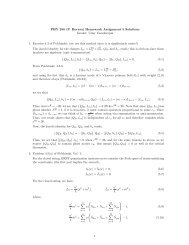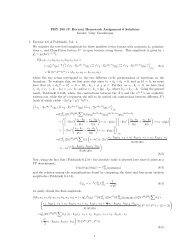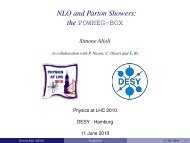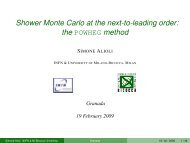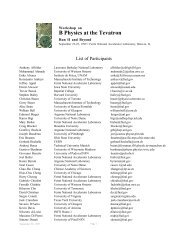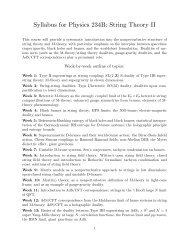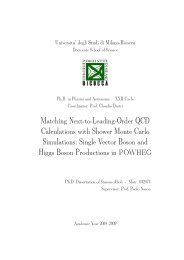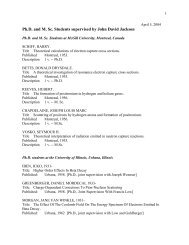Victor Frederick Weisskopf, 1908-2002 - Theoretical Physics at LBNL
Victor Frederick Weisskopf, 1908-2002 - Theoretical Physics at LBNL
Victor Frederick Weisskopf, 1908-2002 - Theoretical Physics at LBNL
Create successful ePaper yourself
Turn your PDF publications into a flip-book with our unique Google optimized e-Paper software.
NATIONAL ACADEMY OF SCIENCESVICTOR FREDERICK WEISSKOPF<strong>1908</strong>–<strong>2002</strong>A Biographical Memoir byJ. DAVID JACKSON AND KURT GOTTFRIEDAny opinions expressed in this memoir are those of the authorsand do not necessarily reflect the views of theN<strong>at</strong>ional Academy of Sciences.Biographical Memoirs, VOLUME 84PUBLISHED 2003 BYTHE NATIONAL ACADEMIES PRESSWASHINGTON, D.C.
Photo by Heka Davis, AIP Emilio Segré Visual Archives, <strong>Physics</strong> Today Collection
VICTOR FREDERICK WEISSKOPFSeptember 19, <strong>1908</strong>–April 22, <strong>2002</strong>BY J. DAVID JACKSON AND KURT GOTTFRIEDVICTOR FREDERICK WEISSKOPF was a major figure in the goldenage of quantum mechanics, who made seminal contributionsto the quantum theory of radi<strong>at</strong>ive transitions, theself-energy of the electron, the electrodynamic propertiesof the vacuum, and to the theory of nuclear reactions. Inthe broader arena through his writings and actions he wasan effective advoc<strong>at</strong>e for intern<strong>at</strong>ional cooper<strong>at</strong>ion in scienceand human affairs. In 1981 he shared the Wolf Prizefor physics with Freeman Dyson and Gerhard ‘t Hooft for“development and applic<strong>at</strong>ion of the quantum theory offields.” In 1991 he was awarded the Public Welfare Medalof the N<strong>at</strong>ional Academy of Sciences “for a half-century ofunflagging effort to humanize the goals of science, acquaintthe world with the beneficial potential of nuclear technologies,and to safeguard it from the devast<strong>at</strong>ion of nuclearwar.” As a member of the Pontifical Academy of Scienceshe was instrumental in persuading the Pope to speak onthe dangers of nuclear weapons.<strong>Weisskopf</strong> was born in Vienna, Austria, on September19, <strong>1908</strong>. In his nineties and increasingly frail, he died <strong>at</strong>home in Newton, Massachusetts, on April 22, <strong>2002</strong>. Growingup in Vienna in a well-to-do Jewish family, he had a3
VICTOR FREDERICK WEISSKOPFties, and presciently enunci<strong>at</strong>ing the concept of chargerenormaliz<strong>at</strong>ion. With the increasing persecution of Jews inNazi Germany and the prospect of war, he and his wifedecided to look for ways to escape Western Europe. Toenhance his chances <strong>Weisskopf</strong> began to work in the increasinglyimportant field of nuclear physics, which occupiedmany <strong>at</strong> Bohr’s institute, and to publish in English.Although he had job offers from the Soviet Union, after avisit in l<strong>at</strong>e 1936 he and his wife decided th<strong>at</strong> he wouldconsider them only as a last resort. With Bohr’s help he wasoffered a lectureship <strong>at</strong> the University of Rochester beginningin the fall of 1937.He was on the Rochester faculty for five and one-halfyears. During th<strong>at</strong> time he continued research in nuclearphysics but also on the electrodynamics of the electron. Hereturned to the self-energy problem and in 1939 establisheda result little appreci<strong>at</strong>ed <strong>at</strong> the time or now: th<strong>at</strong> in thenth order of perturb<strong>at</strong>ion theory the self-energy divergesonly as the nth power of a logarithm.In early 1943 <strong>Weisskopf</strong> was invited to Los Alamos, wherehe soon became Hans Bethe’s deputy in the theoreticalphysics group. Already famous for his physical intuition, hewas much sought after by the experimenters to provide estim<strong>at</strong>esof little known or little understood nuclear processes.He served for a time as mayor of Los Alamos, evidence ofhis humanity and social responsibility.In early 1946 he joined the physics faculty <strong>at</strong> the MassachusettsInstitute of Technology, where with one substantialbreak he remained until retirement in 1974. His researches<strong>at</strong> MIT focused on nuclear reactions, with onemajor paper with J. Bruce French on a complete calcul<strong>at</strong>ionof the leading radi<strong>at</strong>ive correction to <strong>at</strong>omic energylevels (the Lamb shift). The nuclear physics work was donemainly in collabor<strong>at</strong>ion with Herman Feshbach, sometimes5
6 BIOGRAPHICAL MEMOIRSaugmented by students and postdocs. These papers aremarked by their clarity, the simplicity of the assumptions,and their close connection to experiment. Together withJohn Bl<strong>at</strong>t he authored an influential text on theoreticalnuclear physics, published in 1952. Th<strong>at</strong> same year he waselected a member of the N<strong>at</strong>ional Academy of Sciences.In 1961 <strong>at</strong> the apex of his career as an academic researcher<strong>Weisskopf</strong> was invited to be director general ofCERN, the European center for high-energy physics nearGeneva, Switzerland. For CERN it was an inspired choice.<strong>Weisskopf</strong> provided intellectual leadership and a vision ofthe labor<strong>at</strong>ory as an intern<strong>at</strong>ional research center secondto none. He successfully promoted construction of the firstproton-proton collider, the intersecting storage rings, andsaw to the eventual building of a 300-GeV acceler<strong>at</strong>or. Heset CERN on its p<strong>at</strong>h to be a preeminent, some would saythe preeminent, research center in high-energy physics today.At the end of his five-year term he returned to MIT,where he was named Institute Professor and chaired the<strong>Physics</strong> Department for six years (1967-73). During theseyears he pursued occasional research, but devoted increasingfractions of his time to writing, invited lectures, andpublic service. He published popular expositions of science,collections of essays on science, science in public affairsand scientific personalities, and his autobiography. Afterretirement he continued writing and giving informal talksto explain the wonders of science to the lay public.From near the end of the Second World War <strong>Weisskopf</strong>was active in discussion of the promise of nuclear energyand the dangers of nuclear weapons. He was among thefounders of the Feder<strong>at</strong>ion of Atomic Scientists, a memberof the Emergency Committee of Atomic Scientists chaired
VICTOR FREDERICK WEISSKOPFby Albert Einstein, and a participant in the early Pugwashmeetings.<strong>Weisskopf</strong> served as president of the American PhysicalSociety in 1960. He was elected to numerous learned societiesin addition to the N<strong>at</strong>ional Academy of Sciences andreceived many honorary degrees. He received several prizesand medals, including the Max Planck Medal in 1956, theN<strong>at</strong>ional Medal of Science in 1980, and the already notedWolf Prize in 1981 and the Public Welfare Medal in 1991.EARLY YEARSViki (the nickname by which he was universally known)<strong>Weisskopf</strong> was the second of three children born into acomfortably middle-class Jewish family. His f<strong>at</strong>her, Emil, originallyfrom Czechoslovakia, was a successful lawyer; his mother,Martha, was from an upper-middle-class nonobservant JewishViennese family. The family saw to it th<strong>at</strong> young <strong>Victor</strong>and his siblings were exposed to the rich cultural offeringsof Vienna—concerts, the opera, the<strong>at</strong>er—with summers <strong>at</strong>Altaussee. He studied the piano and developed a lifelonglove of music. In his l<strong>at</strong>e teens he even considered seriouslybecoming a professional musician. He <strong>at</strong>tended a progressiveelementary school and then a gymnasium. There hisinterest in science, especially astronomy and physics, flourished.While <strong>at</strong> their summer home in Altaussee southeast ofSalzburg in August 1923, Viki and friend George Winterspent several hours on top of an 1,800-m peak, where theyobserved a total of 98 shooting stars of the annual Perseidshower, which they classified as to color and appearance.The results of their investig<strong>at</strong>ion were published inAstronomische Nachrichten (1924). It is not many of uswho can claim a first research public<strong>at</strong>ion <strong>at</strong> age 15 and ahalf!7
8 BIOGRAPHICAL MEMOIRSAt the gymnasium particip<strong>at</strong>ion in youth groups was thenorm; Viki joined the young socialists and in 1926 tookpart in performances of political s<strong>at</strong>ire in Vienna cabarets.For two years he <strong>at</strong>tended the University of Vienna, wherehe found inspir<strong>at</strong>ion in Hans Thirring’s lectures in classicaltheoretical physics. Thirring, sensing <strong>Weisskopf</strong>’s exceptionalabilities and knowing th<strong>at</strong> Vienna was not in the forefrontin modern physics, recommended th<strong>at</strong> he transfer toGöttingen for further studies. Göttingen <strong>at</strong> th<strong>at</strong> time wasthe Mecca of theoretical physics, where Heisenberg, Born,and Jordan had invented quantum mechanics in 1925-26.GÖTTINGENAt Göttingen Viki became a doctoral student of MaxBorn, the professor of theoretical physics. In his autobiography1 Born remembers the young man.Another member of my group of research students was <strong>Victor</strong> <strong>Weisskopf</strong>,who came from Vienna. He was <strong>at</strong> first very timid, and several times camenear to giving up theoretical physics when he made a blunder in his reasoning.But I encouraged him and succeeded in keeping him on his p<strong>at</strong>h.Viki’s insecurity over his potential for mistakes came tothe surface from time to time throughout his career, as wenote below.Born’s duties and poor health left Viki largely on hisown. After learning quantum mechanics from GerhardHerzberg, Viki embarked on research on the interaction ofradi<strong>at</strong>ion with m<strong>at</strong>ter, a broad subject of central importanceand one to which <strong>Weisskopf</strong> would make major contributions.He <strong>at</strong>tacked his first unsolved problem: the n<strong>at</strong>uralwidth of spectral lines in emission of radi<strong>at</strong>ion by <strong>at</strong>oms.He was able to make progress on a two-level quantum systembut not beyond. He sought help from Eugene Wigner,who was then in Berlin but who came back to Göttingen for
VICTOR FREDERICK WEISSKOPFregular visits. Wigner became Viki’s mentor and the collabor<strong>at</strong>ionled to two papers. The first, most important paper(1930) tre<strong>at</strong>s the exponential decay of excited <strong>at</strong>omicst<strong>at</strong>es and the n<strong>at</strong>ural breadth of the associ<strong>at</strong>ed spectrallines for all types of transitions. In contrast to the semiclassicalresult where an intense line was necessarily broadand a weak line narrow, the quantum theory accommod<strong>at</strong>esthe occasional puzzling broad but weak line.His doctoral thesis (1931) described the applic<strong>at</strong>ion ofthe theory to resonance fluorescence, the absorption andre-emission of light by <strong>at</strong>oms. The thesis has had considerableimpact in <strong>at</strong>omic spectroscopy over the years. 2POSTDOCTORAL YEARSIn the years 1931-37 Viki had the most remarkable ofpostdoc careers, first with Heisenberg in Leipzig, thenSchrödinger in Berlin, Bohr in Copenhagen, Pauli in Zürich,and then Bohr again. This history speaks not only to howViki’s talents and promise were judged by the leaders oftheoretical physics but also to the scarcity of long-term positionsduring the Gre<strong>at</strong> Depression. The job shortage wasgre<strong>at</strong>ly compounded for Viki by the exclusion of Jews fromnumerous academic posts in Germany after the Nazis cameto power in 1933. Rockefeller fellowships and Bohr’s hospitalityin Copenhagen played central roles for temporaryopportunity and sustenance for many.As a new Ph.D. Viki went first to Leipzig, funded by hisfamily, to work with Heisenberg. At Christmas 1931Schrödinger invited him to Berlin for the spring term to behis Assistent in Fritz London’s temporary absence. As hetold one of us (K.G.) l<strong>at</strong>e in life, Schrödinger would sometimestelephone shortly before he was to lecture and askViki to substitute, which Viki so many decades l<strong>at</strong>er acknowledgedwith boyish embarrassment as having been occasioned9
10 BIOGRAPHICAL MEMOIRSby the professor’s assign<strong>at</strong>ions. Schrödinger showed anotherside by arranging a one-year Rockefeller Fellowship for Vikito begin in the fall of 1932. For the long summer periodViki and his current girl friend went to Kharkov in theSoviet Union, where Lev Landau was. This was the first ofseveral trips to the Soviet Union, trips th<strong>at</strong> both opened hiseyes to the evils of the regime and made friendships withSoviet scientists th<strong>at</strong> were useful in different ways l<strong>at</strong>er inhis life.During his postdoc period Viki developed close friendshipswith many young colleagues who were rapidly becomingprominent physicists, especially P<strong>at</strong>rick Blackett, FelixBloch, Hendrik Casimir, Rudolf Peierls, and George Placzek,as well as Max Delbrück, who left quantum field theory tobecome a gre<strong>at</strong> pioneer in molecular biology. And in 1932on his second day in Copenhagen Viki met Ellen Tvede,who was soon to be his wife and constant companion untilher de<strong>at</strong>h in 1989. By this time Viki seemed to have lost theshyness remarked on by Born. In his reminiscences 3 HendrikCasimir notes th<strong>at</strong> in Copenhagen Viki particip<strong>at</strong>ed in theentertainments <strong>at</strong> Bohr Institute conferences by “provid[ing]both poetry and song” and by taking the role of the DalaiLama.Three central problems of quantum electrodynamics(QED) were the focus of Viki’s research during his postdoctoralperiod: the role of antiparticles, the self-energy ofthe electron, and the properties of the vacuum in QED.The puzzling neg<strong>at</strong>ive energy solutions of Dirac’s amazinglysuccessful rel<strong>at</strong>ivistic wave equ<strong>at</strong>ion were in 1932 proposedby Dirac to correspond to antiparticles of the same mass asthe electron but of opposite charge, an interpret<strong>at</strong>ion th<strong>at</strong>was highly controversial. Nevertheless, such particles werediscovered in cosmic-ray experiments l<strong>at</strong>er th<strong>at</strong> year, butth<strong>at</strong> these objects were indeed Dirac’s antiparticles was not
VICTOR FREDERICK WEISSKOPFclear for some time. Meanwhile the description of the selfenergyof the electron using Dirac’s electrons alone (positiveenergy solutions only) led to a badly divergent result.Understanding of both these problems was gre<strong>at</strong>ly advancedin two papers written during Viki’s two and a halfyears as Pauli’s Assistent in Zürich (fall 1933-spring 1936).At Pauli’s suggestion Viki computed the electron’s self-energyin perturb<strong>at</strong>ion theory, including both electrons andpositrons. In doing this calcul<strong>at</strong>ion Viki made a sign error,which was quickly pointed out by Wendell Furry; when thiswas taken into account, the result was a self-energy th<strong>at</strong>diverged logarithmically as the electron’s radius a tendedto zero (1934). 4 This was an astonishing result: Classicalelectrodynamics was long known to produce a linear divergence,and the one-particle version of QED, already mentioned,yielded a quadr<strong>at</strong>ically divergent self-energy. The“soft” logarithmic divergence of QED with electrons andpositrons was a first indic<strong>at</strong>ion th<strong>at</strong> QED might be made <strong>at</strong>ractable theory.Viki was very discouraged by his error in the self-energycalcul<strong>at</strong>ion, which exacerb<strong>at</strong>ed his lack of m<strong>at</strong>hem<strong>at</strong>ical selfconfidence.“[I] told Pauli th<strong>at</strong> I wanted to give up physics,th<strong>at</strong> I would never survive this blemish on my professionalrecord.” (1991, p. 80). Pauli, like Born before, urged himnot to take it too hard, th<strong>at</strong> it would not end his career.And so it proved.The second Zürich paper, written with Pauli, dealt withthe quantiz<strong>at</strong>ion of the charged scalar field (1934). 4 At thetime, this work was viewed as a purely theoretical exercisefor no “elementary’’ spin zero particle was known. It was,however, an exercise th<strong>at</strong> taught an important lesson, becauseit demonstr<strong>at</strong>ed th<strong>at</strong> antiparticles are not a peculiarityof Dirac’s theory for spin 1/2 fermions but are also aninevitable fe<strong>at</strong>ure of a quantum field theory for charged11
12 BIOGRAPHICAL MEMOIRSbosons. Furthermore, the Pauli-<strong>Weisskopf</strong> paper demonstr<strong>at</strong>edth<strong>at</strong> a marriage of rel<strong>at</strong>ivity and quantum mechanicsdoes not require spin 1/2 as many had incorrectly inferredfrom Dirac’s theory, and th<strong>at</strong> scalar QED gave resultsfor physical processes similar to spin 1/2 QED. And withthe advent of Hideki Yukawa’s meson theory of nuclearforces, the scalar field theory became more than a settingupexercise for theoreticians.COPENHAGEN AGAINViki had been very productive during his first year inZurich, perhaps in part because he was alone. Ellen and hehad agreed to test their love with a one-year separ<strong>at</strong>ion.The test proved successful, and they were married inCopenhagen on September 4, 1934. During the remainderof his time in Zurich he continued to work on topics inelectrodynamics, beginning with an investig<strong>at</strong>ion of the propertiesof the vacuum in QED. This line of study reached fullfruition in Copenhagen in 1936, where he held a fellowshipwith Bohr (April 1936-September 1937). At the BohrInstitute nuclear physics was beginning to be emphasizedin addition to basic problems in quantum mechanics andfield theory. Of the stimul<strong>at</strong>ing <strong>at</strong>mosphere <strong>at</strong> the instituteViki says, “Influenced by this remarkable group, I wrote twoof my best papers during th<strong>at</strong> time.” (1991, p. 95).The first of these is a classic paper on the polariz<strong>at</strong>ionof the vacuum caused by the virtual electron-positron pairsunder the influence of a uniform electromagnetic field ofarbitrary strength (1936). 4 Although this topic had alreadybeen studied, the earlier work was very formal and markedby ambiguities. Viki largely cleared these up in this investig<strong>at</strong>ion,the technically most sophistic<strong>at</strong>ed of his career. Especiallynoteworthy was his prescient recognition of chargerenormaliz<strong>at</strong>ion, in which he exploited the analogy with a
VICTOR FREDERICK WEISSKOPFcharge placed in a polarizable medium to conclude th<strong>at</strong>vacuum polariz<strong>at</strong>ion produces an unobservable (though infinite)constant factor multiplying all charges and electromagneticfield oper<strong>at</strong>ors.It had become clear to Viki by 1936 th<strong>at</strong> an Austrian Jewhad better leave Europe for the United St<strong>at</strong>es. This was fareasier said than done, however, because there were hardlyany positions available in the United St<strong>at</strong>es, or elsewherefor th<strong>at</strong> m<strong>at</strong>ter, and many highly qualified physicists whoanticip<strong>at</strong>ed a Nazi onslaught were competing for them. Tofurther his chances Viki decided th<strong>at</strong> he should publishsomething on the new rage (nuclear physics) and do so inEnglish. He carried this off brilliantly with the second ofhis Copenhagen papers—an original applic<strong>at</strong>ion of st<strong>at</strong>isticalmechanics to the evapor<strong>at</strong>ion of neutrons from nuclei—and published his results in Physical Review (1937).Viki’s first opportunities to leave were a professorshipin Kiev and a senior research position in Moscow. In l<strong>at</strong>e1936 he and Ellen visited the Soviet Union and promptlyrealized th<strong>at</strong> the political clim<strong>at</strong>e had deterior<strong>at</strong>ed drasticallysince Viki’s earlier visit to Russia. He would thereforeonly consider a position there if nothing else were available.In those years Bohr went regularly to England andAmerica to “sell’’ the refugees <strong>at</strong> his institute. In 1937 Bohrconvinced the University of Rochester to offer Viki a poorlypaid instructorship, which he accepted.ROCHESTER AND LOS ALAMOSIn the fall of 1937 Viki began a new phase of his careerwith a new country, a new language, and a largely newfield. In his five and a half years <strong>at</strong> Rochester, nuclear physicsbecame a major focus of his research, with studies ofCoulomb excit<strong>at</strong>ion 5 and radi<strong>at</strong>ive transitions (1941) beingespecially noteworthy. He continued to work on QED and13
14 BIOGRAPHICAL MEMOIRSpublished a remarkable paper addressing the self-energyproblem in gre<strong>at</strong>er detail, but more significantly provingth<strong>at</strong> the self-energy diverges logarithmically to all orders inperturb<strong>at</strong>ion theory (1939). This paper strengthened hisresult of 1934.Fission was discovered in Berlin in December 1938, andon September 1, 1939, Germany invaded Poland. Nuclearphysics was suddenly transformed from an esoteric intellectualpursuit into a potentially decisive factor in the war.Not being a citizen—indeed, an enemy alien until he andEllen became U.S. citizens in 1943—Viki did not particip<strong>at</strong>ein secret war-rel<strong>at</strong>ed work until early 1943, when RobertOppenheimer asked him to come to Los Alamos, wherehe remained until l<strong>at</strong>e in 1945.No d<strong>at</strong>a were then available for many of the processesinvolved in producing a nuclear explosion or the ensuingeffects. The bomb project had to rely on theorists for guidanceon many fronts. Viki became a prominent member ofthe theoretical physics division: His office was known as“the se<strong>at</strong> of the oracle” in recognition of his ability to quicklydevise qualit<strong>at</strong>ive solutions to physics problems. Hans Bethe,the division head, eventually needed support in runninghis expanding team and appointed Viki as his deputy. Becausehe had been in charge of the calcul<strong>at</strong>ions about theeffects of the bomb, Viki was one of the few theorists towitness the Trinity test <strong>at</strong> Alamogordo.MIT AND QED AGAINIn early 1946 Viki joined the faculty <strong>at</strong> MIT and duringth<strong>at</strong> fall began teaching and research again. With his studentBruce French he revisited the electron self-energy problemto explore an earlier suggestion of Hendrik Kramersth<strong>at</strong> one might make sense of the higher-order radi<strong>at</strong>ivecorrections in electrodynamics in spite of the infinity in the
VICTOR FREDERICK WEISSKOPFself-energy of the electron. Kramers had pointed out th<strong>at</strong>wh<strong>at</strong> is actually observable is the energy difference betweenfree and bound st<strong>at</strong>es of electrons. Viki’s demonstr<strong>at</strong>ionth<strong>at</strong> the divergence is only logarithmic made it plausibleth<strong>at</strong> differences would be finite and meaningful. Frenchand <strong>Weisskopf</strong> had not completed their calcul<strong>at</strong>ion when,in June 1947, Willis Lamb announced the results of hismicrowave experiments on hydrogen, showing a tiny disagreementwith existing theory, with a very small energydifference between two levels supposedly degener<strong>at</strong>e. Manytheorists pounced on this result, which became known asthe “Lamb shift.” Bethe quickly showed in a nonrel<strong>at</strong>ivisticcalcul<strong>at</strong>ion with a cutoff th<strong>at</strong> Kramer’s idea led to a levelshift close to th<strong>at</strong> measured by Lamb. His work depended,however, on the plausible but unproven assumption th<strong>at</strong>the logarithmic divergences <strong>at</strong> high energy exactly canceled.By early 1948 French and <strong>Weisskopf</strong> completed the firstconsistent calcul<strong>at</strong>ion of the Lamb shift, but Viki would notpublish because they had a very small disagreement withthe independent calcul<strong>at</strong>ions of Richard Feynman and JulianSchwinger, who agreed with each other. Viki could not believeth<strong>at</strong> his work with French was correct. Surely the twoyoung geniuses who were using their new and much morepowerful techniques had not made the same mistake. Butthey had! The upshot was th<strong>at</strong> French and <strong>Weisskopf</strong> publishedtheir year-old result (1949) only after a paper by Krolland Lamb appeared with essentially the same calcul<strong>at</strong>ion. 6The Kroll-Lamb theory paper contains a succinct st<strong>at</strong>ementabout Viki’s place in the firmament of theoreticalphysics: “[Our] calcul<strong>at</strong>ion,” they wrote, “[is] based on the1927-34 formul<strong>at</strong>ion of quantum electrodynamics due toDirac, Heisenberg, Pauli, and <strong>Weisskopf</strong>.” Despite or perhapsbecause of such praise, in his autobiography Viki indulgesin self-criticism. He laments th<strong>at</strong> he had not had the15
16 BIOGRAPHICAL MEMOIRSinsight to pursue more diligently his 1936 work in which herealized th<strong>at</strong> just the charge and mass of the electron wereaffected by the short-distance (high-frequency) divergences,th<strong>at</strong> he and French did not work hard or fast enough tohave made a prediction of the Lamb shift before its experimentalobserv<strong>at</strong>ion, and th<strong>at</strong> his fear of publishing a wrongresult caused them to miss being the first to publish thecorrect result. His wistful “I might even have shared theNobel Prize with Lamb” (1991, p. 169) sums up his view ofwh<strong>at</strong> might have been. Such regrets aside, <strong>Weisskopf</strong> standsamong the leaders of twentieth-century theoretical physicsand a key player in the development of quantum electrodynamicsand field theory in the 1930s and 1940s, as wasrecognized by the Wolf Prize in 1981.NUCLEAR PHYSICSViki often derided his own technical abilities in theoreticalphysics. He once said he was contributing his “don’tknow how” to a collabor<strong>at</strong>ive effort. But he was justifiablyproud of his remarkable ability to arrive <strong>at</strong> results by intuition,by exploiting basic principles and making educ<strong>at</strong>edguesses. In this regard he would express his gr<strong>at</strong>itude toPaul Ehrenfest, who had been a charism<strong>at</strong>ic visitor toGöttingen when Viki was a student. But as is true of othermasters of the intuitive argument, Viki acquired his magicalability by having devoted his youth to technically difficultcalcul<strong>at</strong>ions. As with the gre<strong>at</strong> pianist who can improviseso effortlessly, an enormous amount of hard, tediouswork lies behind the magic.Nothing illustr<strong>at</strong>es better his talent of focusing on theessential physics with simple intuitive descriptions than hiswork in nuclear physics, his primary interest in the postwarperiod. In this research he found the perfect collabor<strong>at</strong>orin Herman Feshbach. Together and with students and
VICTOR FREDERICK WEISSKOPFpostdocs they published a series of papers on nuclear reactionsth<strong>at</strong> are noteworthy for the clarity, plausibility, andsimplicity of their assumptions (1947, 1949). In addition tohis own research he produced his magnum opus, the tre<strong>at</strong>iseon nuclear physics written in collabor<strong>at</strong>ion with JohnBl<strong>at</strong>t (1952). This became the bible for several gener<strong>at</strong>ionsof nuclear theorists.The most influential paper of this period was withFeshbach and Charles Porter (1954). It describes the totaland elastic sc<strong>at</strong>tering cross section of neutrons (averagedover individual resonances) through a seemingly incomp<strong>at</strong>ibleblend of the single-particle shell model and Bohr’sconcept of the compound nucleus. A vast amount of d<strong>at</strong>a isdescribed remarkably well with this approach. In a littleknown paper Francis Friedman and Viki explored the comp<strong>at</strong>ibilityof the single-particle and compound nucleus pictureswith a masterful mixture of qualit<strong>at</strong>ive and quantit<strong>at</strong>ivearguments (1955).DIRECTOR GENERAL OF CERNBy the l<strong>at</strong>e 1950s Viki was <strong>at</strong> the apex of his researchcareer. He was elected president of the American PhysicalSociety for 1960. In 1961 his appointment as director generalof the European Organiz<strong>at</strong>ion for Nuclear Research(CERN) near Geneva suddenly transformed Viki from anacademic research scientist heading a handful of colleaguesand students into the chief executive of a young, large, andburgeoning multin<strong>at</strong>ional enterprise. Having seenOppenheimer succeed in a similar if much more dram<strong>at</strong>icmetamorphosis, Viki saw fit to tell the CERN Council in his“job interview” th<strong>at</strong> not only did he have no administr<strong>at</strong>iveexperience but “I consider this my strength.” Apparently itwas, for he proved to be an inspiring and imagin<strong>at</strong>ive leader17
18 BIOGRAPHICAL MEMOIRSof the labor<strong>at</strong>ory, and a skillful diplom<strong>at</strong> in the complexpolitical setting in which CERN is governed and funded.When Viki took over as director general, CERN had asuccessful research program in nuclear physics with its synchrocyclotron,but only the beginnings of a high-energyphysics program. Envisioning CERN as a world-class highenergyphysics labor<strong>at</strong>ory, Viki in his first address to theCERN Council <strong>at</strong> the end of 1961 outlined plans for theinnov<strong>at</strong>ive intersecting storage rings (ISR) to be fed by thenew 20-GeV proton synchrotron, and also spoke of a future300-GeV acceler<strong>at</strong>or. During his tenure as director generalthe number of staff and participants more than doubled to2,500. The labor<strong>at</strong>ory began to make major discoveries. Theproposals for the ISR and a 300-GeV machine led to theform<strong>at</strong>ion of an internal committee to assess priorities andcosts, which grew by 1966 into the European Committee onFuture Acceler<strong>at</strong>ors. By the end of Viki’s term in December1965 the ISR had become a reality, as the CERN Councilfunded its construction and also R&D for a 300-GeV acceler<strong>at</strong>or.At CERN Viki is also remembered for his nighttime visitsto the experimental halls and his down-to-earth seminarson particle theory for experimental physicists. A significantfactor in Viki’s decision to seek the CERN positionhad been his desire to learn particle physics—a r<strong>at</strong>her extravagantmeasure for s<strong>at</strong>isfying so modest a wish, but quitetypical of him. This motive charged his many educ<strong>at</strong>ionalactivities <strong>at</strong> CERN with an inspiring enthusiasm.Viki’s controversial championing of the ISR, the world’sfirst proton-proton collider, and also of the 300-GeV machineset the tone and spirit of European high-energy physicsas a serious competitor to the United St<strong>at</strong>es, until thenthe dominant player in the field, with long-lasting significancefor physics everywhere. After returning from Europe
VICTOR FREDERICK WEISSKOPFViki recommended the form<strong>at</strong>ion of the influential HighEnergy <strong>Physics</strong> Advisory Panel to the Atomic Energy Commission(l<strong>at</strong>er the Department of Energy), and was the firstHEPAP chair.RETURN TO MITOn returning to MIT Viki served as department chairfor six years and engaged in intermittent research on particlephysics with junior colleagues. Numerous honors camehis way—the Max Planck Medal (1956), MIT Institute Professor(1966), Pontifical Academy of Sciences (1975), OrdensPour le mérite für Wissenschaften und Künste (1978), theN<strong>at</strong>ional Medal of Science (1980), the Wolf Prize (1981),the Enrico Fermi Award (1988), the Public Welfare Medalof the N<strong>at</strong>ional Academy of Sciences (1991), as well as manyhonorary degrees and foreign memberships to prestigiousacademies. He served for four years as president of theAmerican Academy of Arts and Sciences during a crucialperiod of consolid<strong>at</strong>ion. Along the way he authored a numberof books and collection of essays, including his autobiographyand coauthored (with one of the present authors,K.G.) a two-volume work Concepts of Particle <strong>Physics</strong> (1984,1986) th<strong>at</strong> had its origins in popular lectures to summerstudents <strong>at</strong> CERN. He reached mand<strong>at</strong>ory retirement in1974 and became professor emeritus.CONCERNED SCIENTISTThe thre<strong>at</strong> to humanity posed by nuclear weapons was apreoccup<strong>at</strong>ion of Viki’s ever since he particip<strong>at</strong>ed in thediscussions initi<strong>at</strong>ed by Niels Bohr <strong>at</strong> Los Alamos beforethe Trinity test. After the war Viki was among the Manh<strong>at</strong>tanProject scientists who organized wh<strong>at</strong> became the Feder<strong>at</strong>ionof American Scientists. At th<strong>at</strong> time he was also amember of the small committee chaired by Einstein th<strong>at</strong>19
20 BIOGRAPHICAL MEMOIRSsought to inform the public about the bomb. In the 1950sViki particip<strong>at</strong>ed in the first Pugwash meetings betweenWestern and Soviet nuclear scientists, and continued thereafterto reach out to influential Soviet scientists in pursuitof nuclear arms control. His friendships from the 1930swere of gre<strong>at</strong> advantage. Viki joined the Union of ConcernedScientists when it was founded in the MIT physicsdepartment, which he then chaired, and he l<strong>at</strong>er became amember of its Board of Directors. After his election in 1975to the Pontifical Academy of Sciences Viki played a centralrole in convincing Pope John Paul II to speak out repe<strong>at</strong>edlyagainst the nuclear arms race.Viki worked incessantly for control and reduction ofnuclear weapons and for intern<strong>at</strong>ional cooper<strong>at</strong>ion in science.At CERN he encouraged the reciprocal particip<strong>at</strong>ionof CERN and Soviet-block physicists in each other’s highenergyphysics programs. He believed deeply in the role ofscience and scientists in making the world a more peacefuland safer place.Science is a truly human concern; its concepts and language are the samefor all human beings. It transcends any cultural and political boundaries.Scientists understand each other immedi<strong>at</strong>ely when they talk about theirscientific problems; it is therefore easier for them to speak to each otheron political or cultural questions and problems about which they may havedivergent opinions. The scientific community serves as a bridge across boundaries,as a spearhead of intern<strong>at</strong>ional understanding (1989, pp. 7-8).TEACHING AND STUDENTSNot only was Viki a research scientist, administr<strong>at</strong>or,humanist and intern<strong>at</strong>ionalist, he was also a wonderful teacherand mentor to aspiring physicists. His deep understandingof fundamental principles and his intuition as to wh<strong>at</strong> wasessential made his formal lecture courses inspir<strong>at</strong>ional, de-
VICTOR FREDERICK WEISSKOPFspite his well-known cavalier <strong>at</strong>titude about pedagogic precision(4π was often approxim<strong>at</strong>ed by unity, for example).During his summers <strong>at</strong> CERN after being director generalhe initi<strong>at</strong>ed immensely popular introductory lectures onparticle physics for the summer students, also <strong>at</strong>tended bymany CERN staff. The authors and others continued thetradition; a two-volume work (1984, 1986), already mentioned,was an outgrowth.Teaching also included direction of research, of course.Among students <strong>at</strong> Rochester formally under Viki’s supervisionwere Esther M. Conwell (M.S., 1944) and Ernest D.Courant (M.S., 1942; Ph.D., 1943); Robert Dicke and JohnMarshall, Jr., acknowledge their indebtedness to him in theirtheses. At MIT Viki had 21 Ph.D. students, among them thepresent authors, a Nobel laure<strong>at</strong>e, and MIT faculty colleagues.7MUSICViki’s love affair with the piano and classical music persistedthrough his whole life. In his autobiography half ofthe final chapter (“Mozart, Quantum Mechanics, and a BetterWorld”) is devoted to discussion of his loves in music,both as a listener and a participant. His musical companionsrecognized him as an enthusiastic pianist with a deepappreci<strong>at</strong>ion for Beethoven, Mozart, Schubert, and otherclassical composers. Th<strong>at</strong> music was an integral part of hisbeing is illustr<strong>at</strong>ed by a story told by Maurice Jacob of Viki<strong>at</strong> a public scientific lecture in Paris. 8 Trouble with thesound system caused a few minutes delay. As he waited tobegin Viki noticed a grand piano in the corner of the stage,went over to it, s<strong>at</strong> down, and began to play. The audiencewas enchanted.21
22 BIOGRAPHICAL MEMOIRSCODAA sketch of Viki th<strong>at</strong> is confined to his career, eventhough it was so complex and productive, would only paintthe palest shadow of the man. Wh<strong>at</strong> was really unique aboutViki was his vibrant personality. He conveyed an infectioushappiness—as he put it, “I have lived a happy life in adreadful century!”—for had he not seen Hitler and Stalinin action and witnessed the first engineered nuclear explosion?He maintained this happy disposition even under difficultcircumstances, as when he spent his early months asCERN director in a Boston hospital suspended in an orthopediccontraption following an auto accident in Geneva.Viki’s almost tangible happiness was not just a sign<strong>at</strong>ureof his own personality but was in large measure due to hisgood fortune in having found two wonderful women toaccompany him through life: Ellen Tvede, his wife for 55years until her de<strong>at</strong>h in 1989, and Duscha Scott, his secondwife, who gave him joy and vital support in his final decade.Ellen and Viki had two children after coming to the UnitedSt<strong>at</strong>es: Thomas E. <strong>Weisskopf</strong>, professor of economics <strong>at</strong> theUniversity of Michigan, Ann Arbor, and Karen Worth, seniorscientist, Center for Science Educ<strong>at</strong>ion <strong>at</strong> Educ<strong>at</strong>ionDevelopment Center, Inc., Newton, Massachusetts.<strong>Victor</strong> <strong>Weisskopf</strong> combined in himself two traits th<strong>at</strong> areoften in conflict and rarely coexist so harmoniously: Onone side the sentimental and the romantic, on the otherthe rigorous intellectual discipline and judgment. As heliked to say, his favorite occup<strong>at</strong>ions were Mozart and quantummechanics. He called his popular and wide-rangingexposition of science Knowledge and Wonder (1962). Ingiving talks to lay audiences about cosmology he often playedthe part of Haydn’s Cre<strong>at</strong>ion th<strong>at</strong> accompanies the words“And there was light.” Viki exemplified the vitality and imagi-
VICTOR FREDERICK WEISSKOPFn<strong>at</strong>ion th<strong>at</strong> produced one of history’s gre<strong>at</strong> intellectual revolutions,and gave it a human face.NOTESWe acknowledge our debt to Viki’s autobiography formany factual details. On technical and other m<strong>at</strong>ters wehave lifted unashamedly (with official or tacit permission)from our own writings about Viki in other venues. 9 Wethank the departments of physics <strong>at</strong> the Massachusetts Instituteof Technology and the University or Rochester for assistanceconcerning Viki’s students and other m<strong>at</strong>ters.1. M. Born. My Life. Recollections of a Nobel Laure<strong>at</strong>e. New York:Scribner’s, 1975, p. 235.2. H. H. Stroke. Some <strong>Weisskopf</strong> contributions to <strong>at</strong>omic physics.Phys. Today 56(October 2003), pp. 13-14.3. H. Casimir. Haphazard Reality. New York: Harper, Row, 1983,p. 120-21.4. English transl<strong>at</strong>ions appear in A. I. Miller, Early Quantum Electrodynamics:A Source Book, New York: Cambridge University Press,1994.5. V. F. <strong>Weisskopf</strong>. Excit<strong>at</strong>ion of nuclei by bombardment withcharged particles. Phys. Rev 53(1938):1018(L).6. N. M. Kroll and W. E. Lamb, Jr. On the self-energy of a boundelectron. Phys. Rev. 75(1949):388-98.7. In chronological order the Ph.D. students <strong>at</strong> MIT are DavidHenry Frisch (1947), George J. Yevick (1947), James Bruce French(1948), William Gartland Guindon (1948), David Chase Peaslee (1948),Francis Lee Friedman (1949), John David Jackson (1949), JosephJames Devaney (1950), Edward Joseph Kelly (1950), Murray Gell-Mann (1951), Kerson Huang (1953), Arthur Kent Kerman (1953),Charles Edwin Porter (1953), Harvey Jerome Amster (1954), CharlesLeon Schwartz (1954), Kurt Gottfried (1955), Raymond Stora (1958),John Dirk Walecka (1958), Austin Lowrey (1960), and Gottfried T.Schappert (1961).8. M. Jacob. Knowledge and wonder. In <strong>Victor</strong> F. <strong>Weisskopf</strong> <strong>1908</strong>-<strong>2002</strong>, CERN Courier Commemor<strong>at</strong>ive Issue, December <strong>2002</strong>, pp.18-21.23
24 BIOGRAPHICAL MEMOIRS9. J. D. Jackson. Research highlights. In <strong>Victor</strong> F. <strong>Weisskopf</strong> <strong>1908</strong>-<strong>2002</strong>, CERN Courier Commemor<strong>at</strong>ive Issue, December <strong>2002</strong>, pp. 6-11; K. Gottfried. N<strong>at</strong>ure 417(May 23, <strong>2002</strong>):396; K. Gottfried and J.D. Jackson. Mozart and quantum mechanics. An appreci<strong>at</strong>ion of<strong>Victor</strong> <strong>Weisskopf</strong>. Phys. Today 56(February 2003):43-47.
VICTOR FREDERICK WEISSKOPF25SELECTED BIBLIOGRAPHY1924With G. Winter. Zahl, Farbe, und Aussehen der Perseiden 1923Aug. 10. Astron. Nach. 221:N.5284:64.1930With E. Wigner. Berechnung der n<strong>at</strong>ürlichen Linienbreite auf Grundder Diracschen Lichttheorie. Z. Phys. 63:54-73.1931Zur Theorie der Resonanzfluoreszenz. Ann. Phys. (Leipzig). (5)9:23-66.1934Über die Selbstenergie des Elektrons. Z. Phys. 89:27-39.Berichtigung zu der Arbeit: Über die Selbstenergie des Elektrons.Z. Phys. 90:817-18.With W. Pauli. Über die Quantisierung der skalaren rel<strong>at</strong>ivistischenWellengleichung. Helv. Phys. Acta 7:709-31.1936Über die Elektrodynamik des Vakuums auf Grund der Quantentheoriedes Elektrons, Det. Kgl. Danske Viden. Selskab. M<strong>at</strong>.-fys. Medd. XIV:No. 6.1937St<strong>at</strong>istics and nuclear reactions. Phys. Rev. 52:295-303.1939On the self-energy and the electromagnetic field of the electron.Phys. Rev. 56:72-85.1940With D. H. Ewing. On the yield of nuclear reactions with heavyelements. Phys. Rev. 57:472-85. Err<strong>at</strong>um, ibid., 935.
26 BIOGRAPHICAL MEMOIRS1941Note on the radi<strong>at</strong>ion properties of heavy nuclei. Phys. Rev. 59:318-19.1947With H. Feshbach and D. C. Peaslee. On the sc<strong>at</strong>tering and absorptionof particles by <strong>at</strong>omic nuclei. Phys. Rev. 71:145-58.1949With J. B. French. The electromagnetic shift of energy levels. Phys.Rev. 75:1240-48.With H. Feshbach. A schem<strong>at</strong>ic theory of nuclear cross sections.Phys. Rev. 76:1550-60.1952With J. M. Bl<strong>at</strong>t. <strong>Theoretical</strong> Nuclear <strong>Physics</strong>. New York: John Wiley.1954With H. Feshbach and C. E. Porter. Model for nuclear reactionswith neutrons. Phys. Rev. 96:448-64.1955With F. L. Friedman. The compound nucleus. In Niels Bohr and theDevelopment of <strong>Physics</strong>, eds. W. Pauli, L. Rosenfeld, and V. F. <strong>Weisskopf</strong>,pp. 134-62. New York: McGraw-Hill.1962Knowledge and Wonder: The N<strong>at</strong>ural World as Man Knows It. GardenCity, N.Y.: Doubleday; 2nd ed., Cambridge, Mass.: MIT Press,1979.1967With R. Van Royen. Hadron decay processes and the quark model.Nuovo Cimento ser. X. 50:617-45.1971With J. Kuti. Inelastic lepton-nucleon sc<strong>at</strong>tering and lepton pairproduction in the rel<strong>at</strong>ivistic quark-parton model. Phys. Rev. D4:3418-39.
1972<strong>Physics</strong> in the Twentieth Century: Selected Essays. Foreword by Hans A.Bethe. Cambridge, Mass.: MIT Press.1974With A. Chodos, R. L. Jaffe, K. Johnson, and C. B. Thorn. Newextended model of hadrons. Phys. Rev. D9:3471-95.1984With K. Gottfried. Concepts of Particle <strong>Physics</strong>, vol. 1. New York: OxfordUniversity Press.1986With K. Gottfried. Concepts of Particle <strong>Physics</strong>, vol. 2. New York: OxfordUniversity Press.1989The Privilege of Being a Physicist. Essays. New York: W. H. Freeman.1991The Joy of Insight: Passions of a Physicist. New York: Basic Books.



